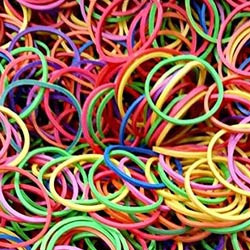Rubber bands are a stretch of rubber and latex in the shape of a loop and are widely used to hold objects together. Rubber bands are known by various names like binder, elastic, elastic bands, lacker band or gumband. These bands are frequently used in many businesses, industries as well as at home. They are well suited for holding multiple objects together and are reusable and economical. Rubber band sizes vary according to their intended use. These elastic rubber band colors too differ. Today, in the 21st century, rubber bands are considered one of the most convenient rubber products, used by many individuals and industries for a wide variety of purposes. Industrial rubber bands are made to perform heavy duty. These industrial rubber bands have specific sizes and are very strong rubber bands , designed to stabilize almost any size load.

